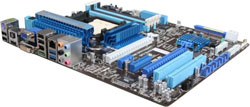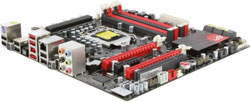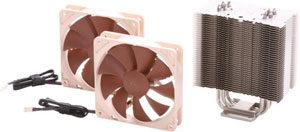Holiday 2010 System Builder's Guide
by AnandTech Staff, edited by Jarred Walton on November 19, 2010 2:00 AM EST- Posted in
- Guides
- Systems
- Holiday 2010
Raja's Midrange Overclocking Systems
What about building a bang-for-the-buck overclocking experience, you ask? As our resident overclocking guru and motherboard reviewer, Raja has more experience with this area than the rest of us so we turned this section over to him. In order to keep things simple, we kept nearly all of the components in Vivek's midrange build but switched out the motherboard, processor, RAM and PSU. We also added an aftermarket cooler to allow the CPUs to reach their full potential. Here's what Raja put together. [Ed: Text by Jarred, most of the picks by Raja.]
| Raja's Midrange AMD Overclocking System | ||
| Hardware | Component | Price |
| Processor |
AMD Phenom II X6 1055T (Thuban 45nm, 2.8 to 3.3 GHz, 6x512KB L2, 6MB L3, 125W |
$179 |
| Motherboard | ASUS M4A89GTD Pro (AMD 890GX AM3) | $135 |
| CPU Cooler | Noctua NH-U12P SE2 120mm SSO | $60 |
| Video | ASUS Radeon HD 6850 1GB (EAH6850) | $200 |
| Memory | G.Skill 2x2GB DDR3-1600 (F3-12800CL9D-4GBNQ) | $65 |
| Hard Drive | WD Caviar Blue 1TB (WD10EALS) | $70 |
| Optical Drive | ASUS 24x DVDRW (DRW-24B1ST) | $20 |
| Power Supply | Seasonic S12II 620W Bronze (80 Plus Bronze) | $75 |
| Case | Antec Nine Hundred Two | $89 |
| Total System Price | $893 | |
For AMD overclocking, I chose one of the hex-core Thuban CPUs, just so you can get every last ounce of performance out of AMD's architecture. The ASUS motherboard ended up being our top AM3 overclocking selection--at least when keeping prices in check--and is good for up to a 50% overclock by raising the base clock. Thuban will  generally top out in the 4.0-4.2GHz range, making this board a perfect fit. The Noctua cooler will help keep things cool without making a ton of noise, and the Seasonic S12II 620W power supply should deliver clean, stable current to the system.
generally top out in the 4.0-4.2GHz range, making this board a perfect fit. The Noctua cooler will help keep things cool without making a ton of noise, and the Seasonic S12II 620W power supply should deliver clean, stable current to the system.
Alternately, if you want to spin the wheel, you can also try your hand at core unlocking and save some money. $100 will buy you the Phenom II X2 560 Black Edition, which has two disabled cores. The ASUS board allows core unlocking, provided your CPU can handle it. Many users have had success with core unlocking, but there's no guarantee, and you'll never get the six cores that Thuban processors offer.
Our memory kit may not look like much, with its DDR3-1600 speed and CAS 9 timings. In reality, it shouldn't limit you but it's getting tricky to determine which memory to buy for overclocking. Vendors are now covering up their IC choices so much it's difficult to know what's inside; what we're looking for is an Elpida BBSE type variant or a similar IC from PSC. The G.Skill kit should work, but YMMV.
| Raja's Midrange Intel Overclocking System | ||
| Hardware | Component | Price |
| Processor |
Intel Core i5-760 Lynnfield 45nm (4x2.8GHz to 3.33GHz Turbo, 8MB L3, 95W) |
$200 |
| Motherboard | ASUS Maximus III GENE (Intel P55 1156) ($20 MIR) | $127 |
| CPU Cooler | Noctua NH-U12P SE2 120mm SSO | $60 |
| Video | ASUS Radeon HD 6850 1GB (EAH6850) | $200 |
| Memory | G.Skill 2x2GB DDR3-1600 (F3-12800CL9D-4GBNQ) | $65 |
| Hard Drive | WD Caviar Blue 1TB (WD10EALS) | $70 |
| Optical Drive | ASUS 24x DVDRW (DRW-24B1ST) | $20 |
| Power Supply | Seasonic S12II 620W Bronze (80 Plus Bronze) | $75 |
| Case | Antec Nine Hundred Two | $89 |
| Total System Price | $906 | |
Okay, first let's get this out of the way: Sandy Bridge is right around the corner. Think your hopped up i5-760 overclock is impressive? Imagine an unlocked Sandy Bridge chip running at 4.3-4.5GHz on air cooling. If you're into Intel overclocking, we'd really consider just waiting a bit longer right now. But, if you must buy a P55 system right now and you want a good overclock....
For the CPU, the i5-760 remains the most sensible choice. Priced at $200, you still get four cores with great overclocking potential--hitting 4.0-4.2GHz is generally common with an appropriate motherboard and cooling. The jump to i7-870 is $80 and all you really get is Hyper-Threading, since maximum  overclocking means you'll want to disable the Turbo Boost feature and most of the Lynnfield CPUs are going to top out around the same 4.2GHz. We might be swayed to make an investment in Core i7 if it weren't for Sandy Bridge; then again, there's an upside: motherboards that used to push nearly $200 have come down quite a bit and there are plenty of rebates going around right now.
overclocking means you'll want to disable the Turbo Boost feature and most of the Lynnfield CPUs are going to top out around the same 4.2GHz. We might be swayed to make an investment in Core i7 if it weren't for Sandy Bridge; then again, there's an upside: motherboards that used to push nearly $200 have come down quite a bit and there are plenty of rebates going around right now.
The motherboard is always a critical component for overclocking, and even though there are plenty of options that can do well, we wanted something more than just a decent overclock. The ASUS Maximus III GENE can easily hit BLCKs far beyond what you'll need for an i5-760, but even better is the excellent voltage regulation that will allow you to push 4GHz and higher without pumping a ton of current through your CPU. ASUS also makes overclocking very easy on the less experienced, with only minor tweaks necessary to get your system running at top speed.
Cooling for both systems comes courtesy of the Noctua NH-U12P SE2, a high quality push-pull cooler capable of keeping your CPU temperatures down without raising noise levels.  While there are decent coolers for a bit less money, we've never been disappointed by the Noctua; it works well even with hex-core processors if you move to X58, so the Lynnfield CPUs aren't going to be a problem.
While there are decent coolers for a bit less money, we've never been disappointed by the Noctua; it works well even with hex-core processors if you move to X58, so the Lynnfield CPUs aren't going to be a problem.
You'll notice that the power supply isn't the OCZ model Vivek used; instead the PSU is a higher quality Seasonic S12II capable of delivering the clean, stable power you'd want in an overclocked system. If you want to move to dual graphics cards and a heavily overclocked CPU, the 620W power supply should still keep up with everything short of the fastest GPUs. If that's what you'd like, I suggest looking at Ryan's X58 high-end SLI build.










112 Comments
View All Comments
prdola0 - Friday, November 19, 2010 - link
In some of the systems, I would buy a GTX460 1GB instead of the HD6850 simply because most people play in 1920x1200 and lower (I would say 1680x1050 as the most common) and in those resolutions the GTX460 is better than the HD6850. It would be also a choice for the next generation of games, if the consoles ever let it come. Otherwise very nice systems.One question though, are all those memories you guys used from QVLs of the motherboards or do you just trust them?
Thanks a lot,
Prdola
ganeshts - Friday, November 19, 2010 - link
The components suggested in my mid-range HTPC build are all tried and tested together :)therealnickdanger - Friday, November 19, 2010 - link
It would be cool if each of these builds was benched and the results were shown... :) I know that's asking a lot, but like Brian said:"Heck, there's no reason you can't at least ask for the absolute best..."
AnnihilatorX - Saturday, November 20, 2010 - link
I'd personally go for HD6850. It runs cooler, uses less power, can double up as high quality sound card (if you have a AV receiver with HDMI, Radeon HD68xx support DTS Master HD, etc).prdola0 - Monday, November 22, 2010 - link
The GTX460 can of course also double up as a high quality soind card. Why wouldn't it?blotto5 - Saturday, November 20, 2010 - link
for 1680x1050 it does perform better, but not by much. for 1920x1200 there is almost no difference, and for any resolution higher than that the 6850 blows it out of the water. when your have an amd processor and an amd chipset it would make sense to stay on the same platform and get an amd video card, everything plays nice together that way.prdola0 - Monday, November 22, 2010 - link
Any nVidia graphics card will work just as good on an AMD system as on an Intel system. How did you find that it wouldn't? That's totally false.And your statement about no difference in 1920x1200 is only valid for the GTX460 768MB. The 1GB version is actually still better at 1920x1200. According to Steam Survey, 74.2% of players play at 1680x1050 or lower resolution and only 4.19% play at higher resolutions than 1920x1200. I still don't understand why all the reviews focus so much on the 2560x1600 resolution. I wish Ryan didn't ignore that fact in his Final Words. But world isn't perfect :)
Quizzical - Friday, November 19, 2010 - link
If Zambezi isn't going to fit Socket AM3, then someone ought to tell AMD.End of page 5 of the AMD codename decoder that they released on financial analyst day:
“Zambezi”
Market: Desktop
What is it? four-, six-, or eight-core 32-nm AM3 socket desktop processor based on
the “Bulldozer” processor architecture for the enthusiast market.
Planned for introduction: 1H 2011
If I give a link, this site apparently flags the comment as spam and disallows it. But you can find it yourself as follows. Do a Google search for "AMD 2010 Financial Analyst Day". Click the (currently) top search result, to a page on AMD's site with that headline. Click the "AMD Codename Decoder" link from that page. The above is a copy and paste from the end of the document.
Dustin Sklavos - Friday, November 19, 2010 - link
Later on in the year they did say they tried to make Bulldozer compatible with the existing AM3 socket but couldn't do it, as a result you get AM3r2, where the motherboards will be backwards compatible with old AM3 chips, but the Bulldozer chips aren't going to be compatible with old AM3 boards.Quizzical - Friday, November 19, 2010 - link
The information I quoted was released by AMD last week. "Later on in the year" than that would have to be very, very recent. As I said, if the information that AMD just released is wrong, someone should tell them to fix it.